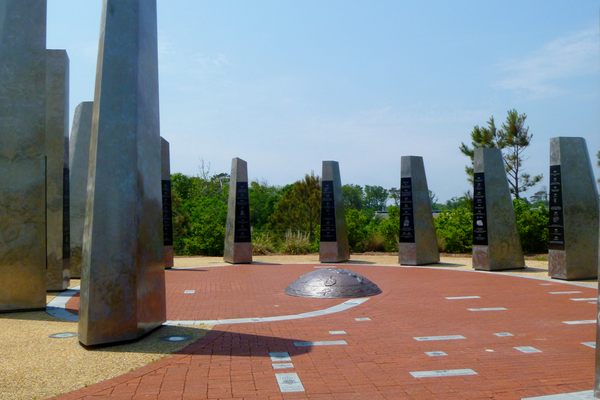The Short-Lived Airline That Shuttled Sightseers to America’s National Parks
National Parks Airways only lasted for 10 years.

In 1872, Yellowstone National Park—which straddles Wyoming, Montana, and Idaho—officially became the first national park in the United States. Though indigenous communities had been living in the geologically stunning region for over 11,000 years, Americans of the 19th century were newly enamored with the park’s vastness. But as the National Park system grew, the sites weren’t always easy to get to, so in a stroke of brilliant business savvy, Alfred Frank founded National Parks Airways in 1927.
The local airline only serviced three states upon its founding—Idaho, Montana, and Utah—which was not unusual for small airlines in the early 20th century. And despite its obviously branded name, the airline did not operate in conjunction with the National Park system in its first years.
The airline’s original fleet consisted of two Stearman C3MB’s (open cockpit mail planes) and three Fokker Super-Universal planes, which were “single-motor aircraft, considered deluxe for the time with a closed cabin,” says Marie K. Force, Archives Director at Delta Flight Museum.* The former operated strictly as airmail carriers. “Securing an airmail contract and then beginning passenger service was the typical beginning for a new airline,” says Force. “To encourage the development of commercial aviation, the U.S. Post Office subsidized the carrying of mail.” Since Stearman C3MB planes were so small and had so few seats, airline owners like Frank could make additional revenue from transporting mail from Salt Lake City, Utah, to Great Falls, Montana (a 500-mile route).

Since the Fokker Super-Universal planes were built to carry just four passengers and NPA’s success was steadily growing, Frank sought to upgrade his fleet with planes that were faster, safer, and more comfortable. “The Boeing 247 aircraft were necessary because on October 31, 1934, the U.S. Post Office required twin-engine aircraft to carry the mail,” says Force. “In November 1934, Alfred Frank leased NPA’s first Boeing 247D from United Air Lines.” These planes were touted as having 10 reclining seats, a two-way radio, a heated cabin, and the ability to hold two pilots. They were also designed to fly 160 miles per hour.
Naturally, as interest in traveling to national parks such as Yellowstone increased, National Park Airways put its name to use and adjusted its business plan. “The name was [initially] for marketing reasons as it connected Salt Lake City with points north to its terminus in Great Falls, near Glacier National Park,” says Bob van der Linden, curator of Air Transportation and Special Purpose Aircraft at the Smithsonian’s National Air and Space Museum. “As airlines expanded across the country, they began marketing to vacation travelers as well as businessmen.”
The promise of serving Americans and their dreams of vacationing in the great outdoors caused Frank to extend his route to Idaho Falls, Idaho, and West Yellowstone, Montana. Both towns are adjacent to Yellowstone National Park, and provided easy access to the grounds. And thanks to the pre-existing relationship the businessman had with United, “Alfred Frank’s airline connected with United Air Lines’ main line route from New York to San Francisco at Salt Lake City,” says van der Linden.

Once National Park Airways was fully engaged with the national park system (it started charting direct flights to Yellowstone National Park in 1936), other unique perks followed: During the summer months of 1935 through 1937, the airline operated a local sightseeing flight out of West Yellowstone Airport. But around 1936, Frank started seeking other pursuits. Existing airmail contracts had been cancelled by the U.S. Post Office in February 1934, and mail pay rates had decreased, so the airline’s profits were dwindling. Selling National Parks Airways to a larger airline made sense, since the cost of operating a multi-engine aircraft with limited room for passengers was steep for a small operation.
On July 31, 1937, Western Air Express (later Western Airlines) purchased the airway route NPA occupied. Western wanted to expand their route structure in the western United States, and since this overlapped with NPA’s route stop in Salt Lake City, they eventually acquired the entire National Parks Airways airline. “We have a 1936 brochure that promotes a joint NPA-WAE package vacation ‘Sky Tours / America’s Greatest Vacation by Air,’ with highlighted attractions including San Diego, Los Angeles, Boulder Dam, Zion National Park, Salt Lake City, Yellowstone National Park, and Montana dude ranches,” says Force of the Delta Flight Museum’s archives. (Delta and Western Airlines merged in 1987.)
The collapsing of National Parks Airways into Western Airlines proved to be a complementary fit, as the pilots for both airlines had experience flying over rocky western terrain. And thus, the 10 year reign of the little local airline that merged national park land and the sky came to a close.
*Correction: This article previously stated the original fleet of National Park Airways consisted of two Stearman C3MB’s. In fact, there were three Fokker Super-Universal planes in the original fleet as well.
















Follow us on Twitter to get the latest on the world's hidden wonders.
Like us on Facebook to get the latest on the world's hidden wonders.
Follow us on Twitter Like us on Facebook